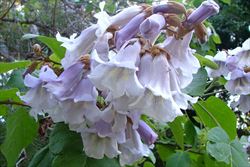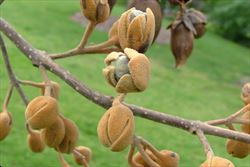Click on images to enlarge

habit in flower in early spring (Photo: Sheldon Navie)

habit in late spring with new foliage (Photo: Sheldon Navie)

large heart-shaped or slightly lobed leaves (Photo: Sheldon Navie)

flowers (Photo: Sheldon Navie)

close-up of flower (Photo: Sheldon Navie)

young fruit (Photo: Sheldon Navie)

mature fruit (Photo: Sheldon Navie)

flowers of the very similar, and also potentially invasive, Paulownia fortunei (Photo: Sheldon Navie)

close-up of seeds (Photo: Steve Hurst at USDA PLANTS Database)
Scientific Name
Paulownia tomentosa (Thunb.) Steud.
Synonyms
Bignonia tomentosa Thunb.
Family
Scrophulariaceae
Common Names
butterfly tree, Chinese empress tree, empress of China, empress tree, empress-tree, empresstree, foxglove tree, foxglove-tree, karri tree, karritree, paulownia, paulownia tree, princess tree, princess-tree, princesstree, royal paulownia, royal paulownia tree
Origin
Native to China.
Naturalised Distribution
This species is sparingly naturalised in central Queensland. It is possibly also naturalised in New South Wales and other parts of Queensland.
Also naturalised overseas in New Zealand and widely naturalised in eastern USA.
Notes
Princess tree (Paulownia tomentosa) is regarded as a "sleeper weed" or emerging, but potentially serious, environmental weed in Queensland and New South Wales. It was recently listed as a priority environmental weed in at least one Natural Resource Management region.

